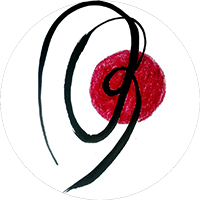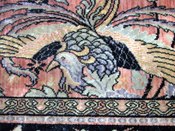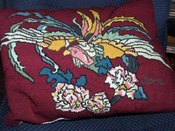Needlepoint pillow designed and worked by Tammy Vitale
Today’s picture is just for something different. This rug is now in my office, one of two that were in my parent’s house from 1950 when they moved in until 1994 when I closed the house and sold it. I worked the pillow for my Mom in 1976/77, gave it to her for Christmas. For a while, I designed needlepoint canvas for a shop in Florida – I think he got the best of it as I knew nothing about pricing, but it was fun and I enjoyed it.
Listened in on my first OneCoach weekly call last night with the invited speaker. There was time for questions and answers and some introductions. It was very interesting and there is a follow-up "freebie" with the speaker to work on the theme of her call which was the "million dollar message." Essentially this is a marketing strategy somewhere between an elevator speech (and here and here) and a USP (don’t you love this jargon?). An elevator speech is that one minute speech you give to someone who might be interested in your work or whom you wish to get interested in your work. A USP is your "unique selling proposition" – meant to capture someone’s interest in a second….as best I can tell, another term for "tagline."
As I listened, it occurred to me that for artists the Marketing Plan is the heart of any Business Plan they might put together. Thus, this morning I went looking for Marketing Plan templates. The first I found was good enough that I didn’t look further. Check out KnowThis.com’s tutorial. Browse it and notice the things it asks you. Don’t get overwhelmed because it looks like, and is, a lot of research (that is not readily available – I know. I’ve spend a good bit of time trying to track down information on art sales/trends on the internet in the past two days with nothing to show for it).
Don’t despair, use it as a thinking cap. If you can’t find art trends, what other areas might reflect trends that would be helpful to know? Art: disposable income: clothes, shoes, dinner out, cars, travel. I still haven’t found anything, but now I can read the business section and watch those sectors, or browse financial info magazines.
Also, we all know that here in the states, the housing market has gone bust (I am intimately familiar with trying to sell in this market, having chosen it to try to sell property of my own – to no avail). People will be staying put. What can art do for them? Freshen up their walls, create sacred spaces of serenity and calm, provide interest and conversation at gatherings. Marketing is about identifying what your clients want, may not even know they want, and getting it in front of them in a way that they understand their need. Crass? Exploitive? Or meeting a need? Creating a needed conversation in a person’s world? Only you can decide what you want your art to do and how you will think of it, which will affect how you present it to the world.
Then I went and looked up Thomas Kincaide, and learned new things about him which notched him yet lower in my estimation; nevertheless, the guy is a marketing whiz with art and I can take the pieces that may work for me, and leave the less desirable traits behind. "Painter of Light" would be his million dollar message, I think (even if he did steal that from J.M.W. Turner, who actually was an artist). Check out Suburban Bliss on Kincaide and be sure to read all the comments for a fun start to the day.
thought for the day: To the artist, all problems of art appear uniquely personal. Well, that’s understandable enough, given that not many other activities routinely call one’s basic self-worth into question. But those really personal problems all relate to the making of the art. Once the art has been made, an entirely new set of problems arise, problems that require the artist to engage the outside world. Call them ordinary problems.
Ordinary problems are not, however, trivial problems. Among other things, they consume the larger part of almost every artist’s time. One well-known painter, after several months of careful record keeping, reached the discouraging conclusion that even at best he could free up only six or seven days a month for actually painting, while the remaining twenty-odd days inevitably went to gallery business, studio cleanup [ed note: people do that?!], UPS runs and the like. Moral: There’s one hell of a lot more to art than just making it. In many cases, the art you make today will reach its audience tomorrow only because of a vast societal network geared to arts education, funding, criticism, publication, exhibition and performance.
In many other cases, unfortunately, your art will only reach the world in spite of this network. David Bayles and Ted Orland, Art & fear: Observations on the Perils (and Rewards) of Artmaking.





6 Comments
Reading those comments about Thomas Kincaide made me laugh so hard….just what I needed today as I'm battling a cold. Thanks. His comment about it being art because so many people are buying it is analagous to McDonald's saying their food must be healthy since they've sold billions of burgers!
I have been reading your blog for a while and thought I would comment. I appreciate you sharing your thoughts on marketing. I am drawn to your art(being a mask maker and bead maker in previous incarnations myself!)Good luck with your research.
~Sue O'Kieffe
Tammy-
BIG round of applause for your son – 60 days is a HUGE deal! I was delighted to read your comment earlier. Please know that he is in my prayers. WOOHOO!!! Your heart must be full.
I'm with you on Kincaide.
Good for you, seeking out information to help you as a successful marketeer of your magnificent work. What a cool idea – enhancing a prospective house with artwork!
ugh. kinkade. when i graduated from college i got a job at a new gallery that was opening selling kinkade stuff. i had never heard of him. after 3 weeks of working there i was so disgusted with myself for selling this tripe i had to quit even though i didn't have another job yet. gives me the shivers thinking about it.
those are great ideas about how to turn the stinky housing market into a need for art – freshening up your space, creating a sacred space, etc…
Tammy – I am SOOO with you on Thomas Kincaide. I read somewhere that when people criticized his 'art' he said something like "well, I sell thousands of paintings so it must be art" – of course thousands of a lot of products are sold each day and none of them are considered art. I hate elitism in the art market — but I also hate it when non-artistic people are called artists! Unfortunately many of them, because of their marketing skills, or being in the right place at the right time are elevated to a position that they really shouldn't have. Whoops – better get off my soapbox.